Long-Term Trends in Urban Atmospheric Polycyclic Aromatic Hydrocarbons and Nitropolycyclic Aromatic Hydrocarbons: China, Russia, and Korea from 1999 to 2014
Abstract
1. Introduction
2. Materials and Methods
2.1. Sampling
2.2. Chemicals
2.3. Sample Treatment and Analytical Procedures
3. Results
3.1. Changes in PAH Concentrations over Time
3.2. Changes in NPAH Concentrations over Time
3.3. PAH and NPAH Compositions
4. Discussion
4.1. Sensitive Determination of NPAHs
4.2. Source Analysis
4.3. Comparison of Urban Air BaP Concentrations in Far Eastern Asian Countries
5. Conclusions
Supplementary Materials
Author Contributions
Funding
Acknowledgments
Conflicts of Interest
References
- BP Statistical Review of World Energy. Available online: http://www.bp.com/content/dam/bp/pdf/energy-economics/statistical-review-2016/bp-statistical-review-of-world-energy-2016-full-report (accessed on 19 June 2016).
- International Agency for Research on Cancer. Outdoor Air Pollution a Leading Environmental Cause of Cancer Deaths. 2013. Available online: http://www.iarc.fr/en/media-center/iarcnews/pdf/pr221.E.pdf (accessed on 19 June 2016).
- International Agency for Research on Cancer. IARC on the Evaluation of Carcinogenic Risks to Humans. In Monograph 2013. Volume 1–116. Available online: http://monographs.iarc.fr/ENG/Classification/index.php (accessed on 19 June 2016).
- Ames, B.N.; McCann, J.; Yamasaki, E. Method for detecting carcinogens and mutagens with the salmonella/mammalian-microsome mutagenicity test. Mutat. Res. 1975, 31, 347–364. [Google Scholar] [CrossRef]
- Epstein, S.S.; Fujii, K.; Asahina, S. Carcinogenicity of a composite organic extract of urban particulate atmospheric pollutants following subcutaneous injection in infant mice. Environ. Res. 1979, 19, 163–176. [Google Scholar] [PubMed]
- Hayakawa, K.; Onoda, Y.; Tachikawa, C.; Hosoi, S.; Yoshita, M.; Chung, S.-W.; Kizu, R.; Toriba, A.; Kameda, T.; Tang, N. Estrogenic/antiestrogenic activities of polycyclic aromatic hydrocarbons and their monohydroxylated derivatives by yeast two-hybrid assay. J. Health Sci. 2007, 53, 562–570. [Google Scholar] [CrossRef]
- Motoyama, Y.; Bekki, K.; Chung, S.-W.; Tang, N.; Kameda, T.; Toriba, A.; Taguchi, K.; Hayakawa, K. Oxidative stress more strongly induced by ortho- than para-quinoid polycyclic aromatic hydrocarbons in A549 cells. J. Health Sci. 2009, 55, 845–850. [Google Scholar] [CrossRef]
- Hayakawa, K.; Tang, N.; Nagato, E.G.; Toriba, A.; Sakai, S.; Kano, F.; Goto, S.; Endo, O.; Arashidani, K.; Kakimoto, H. Long term trends in atmospheric concentrations of polycyclic aromatic hydrocarbons and nitropolycyclic aromatic hydrocarbons: A study of Japanese cities from 1997 to 2014. Environ. Pollut. 2018, 233, 474–482. [Google Scholar] [CrossRef] [PubMed]
- Kojima, Y.; Inazu, K.; Hisamatsu, Y.; Okochi, H.; Baba, T.; Nagoya, T. Changes in concentration levels of polycyclic aromatic compounds associated with airborne particulate matter in downtown Tokyo after introducing government diesel vehicle controls. Asian J. Atmos. Environ. 2010, 4, 1–8. [Google Scholar] [CrossRef][Green Version]
- Hama, H.; Tokuda, T.; Izaki, A.; Ohno, T.; Watanabe, Y.; Kanda, T.; Tang, N.; Kameda, T.; Toriba, A.; Hayakawa, K. Variation in polycyclic aromatic hydrocarbons and nitropolycyclic aromatic hydrocarbons in airborne particulates collected in urban Kanazawa, Japan, in last 12 years. J. Jpn. Soc. Atmos. Environ. 2012, 47, 1–8, (In Japanese with English abstract). [Google Scholar]
- Suzuki, G.; Morikawa, T.; Kashiwakura, K.; Tang, N.; Toriba, A.; Hayakawa, K. Variation of polycyclic aromatic hydrocarbons and nitropolycyclic aromatic hydrocarbons in airborne particulates collected in Japanese capital area. J. Jpn. Soc. Atmos. Environ. 2015, 50, 117–122, (In Japanese with English abstract). [Google Scholar]
- Inomata, Y.; Kajino, M.; Sato, K.; Hayakawa, K.; Ueda, H. Spatial and temporal trend of atmospheric benzo[a]pyrene in Japan between 2000 and 2013. J. Jpn. Soc. Atmos. Environ. 2016, 51, 111–123, (In Japanese with English abstract). [Google Scholar]
- Kakimoto, H.; Kitamura, M.; Matsumoto, Y.; Sakai, S.; Kanoh, F.; Murahashi, T.; Akutsu, K.; Kizu, R.; Hayakawa, K. Comparison of atmospheric polycyclic aromatic hydrocarbons and nitropolycyclic aromatic hydrocarbons in Kanazawa, Sapporo and Tokyo. J. Health Sci. 2000, 46, 5–15. [Google Scholar] [CrossRef][Green Version]
- Tang, N.; Tabata, M.; Mishukov, V.F.; Sergineko, V.; Toriba, A.; Kizu, R.; Hayakawa, K. Comparison of atmospheric nitropolycyclic aromatic hydrocarbons in Vladivostok, Kanazawa and Toyama. J. Health Sci. 2002, 48, 30–36. [Google Scholar] [CrossRef]
- Kakimoto, H.; Matsumoto, Y.; Sakai, S.; Kanoh, F.; Arashidani, K.; Tang, N.; Akutsu, K.; Nakajima, A.; Awata, Y.; Toriba, A.; et al. Comparison of atmospheric polycyclic aromatic hydrocarbons and nitropolycyclic aromatic hydrocarbons in an industrialized city (Kitakyushu) and two commercial cities (Sapporo and Tokyo). J. Health Sci. 2002, 48, 370–375. [Google Scholar] [CrossRef]
- Tang, N.; Hattori, T.; Taga, R.; Igarashi, K.; Yang, X.; Tamura, K.; Kakimoto, H.; Mishukov, V.; Toriba, A.; Kizu, R.; et al. Polycyclic aromatic hydrocarbons and nitropolycyclic aromatic hydrocarbons in urban air particulates and their relationship to emission sources in the Pan-Japan Sea countries. Atmos. Environ. 2005, 39, 5817–5826. [Google Scholar] [CrossRef]
- Hattori, T.; Tang, N.; Tamura, K.; Hokoda, A.; Yang, X.-Y.; Igarashi, K.; Ohno, M.; Okada, Y.; Toriba, A.; Hayakawa, K. Profiles of particulate-bound polycyclic aromatic hydrocarbons and their nitrated derivatives in three typical cities, Liaoning Province, China. Environ. Forensics 2007, 8, 165–172. [Google Scholar] [CrossRef]
- Tang, N.; Suzuki, G.; Morisaki, H.; Tokuda, T.; Yang, X.; Zhao, L.; Lin, J.; Kameda, T.; Toriba, A.; Hayakawa, K. Atmospheric behaviors of particulate-bound polycyclic aromatic hydrocarbons and nitropolycyclic aromatic hydrocarbons in Beijing, China from 2004 to 2010. Atmos. Environ. 2017, 152, 354–361. [Google Scholar] [CrossRef]
- Araki, Y.; Tang, N.; Ohno, M.; Kameda, T.; Toriba, A.; Hayakawa, K. Analysis of atmospheric polycyclic aromatic hydrocarbons and nitropolycyclic aromatic hydrocarbons in gas/particulate phases separately collected by a high-volume air sampler equipped with a column packed with XAD-4 resin. J. Health Sci. 2009, 55, 77–85. [Google Scholar] [CrossRef]
- Hayakawa, K.; Kitamura, R.; Butoh, M.; Imaizumi, N.; Miyazaki, M. Determination of diamino- and aminopyrenes by high performance liquid chromatography with chemiluminescenece detection. Anal. Sci. 1991, 7, 573–577. [Google Scholar] [CrossRef]
- Hayakawa, K.; Murahashi, T.; Butoh, M.; Miyazaki, M. Determination of 1,3-, 1,6-, and 1,8-dinitropyrenes and 1-nitropyrene in urban air by high-performance liquid chromatography using chemiluminescence detection. Environ. Sci. Technol. 1995, 29, 928–932. [Google Scholar] [CrossRef] [PubMed]
- Tang, N.; Taga, R.; Hattori, T.; Toriba, A.; Kizu, R.; Hayakawa, K. Simultaneous determination of twenty-one mutagenic nitropolycyclic aromatic hydrocarbons by high-performance liquid chromatography with chemiluminescence detection. In Bioluminescence and Chemiluminescence Progress and Perspective; Tsuji, A., Ed.; World Science: London, UK, 2005; pp. 441–444. [Google Scholar]
- World Health Organization. Health Risks of Persistent Organic Pollutants from Long-Range Transboundary Air Pollution; WHO Regional Office for Europe: Copenhagen, Denmark, 2003. [Google Scholar]
- World Health Organization. Review of Evidence on Health Aspects of Air Pollution REVIHAAP Project 2013; WHO Regional Office for Europe: Copenhagen, Denmark, 2013. [Google Scholar]
- European Environment Agency. Air Quality in Europe-2018 Report No. 12 2018; Publications Office of the European Union: Copenhagen, Denmark, 2018. [Google Scholar]
- Ministry of Environment Protection of China. Ambient Air Quality Standard GB3095; Ministry of Ecology and Environment the People’s Republic of China: Beijing, China, 2012. Available online: http://english.mee.gov.cn (accessed on 7 January 2020).
- Ministry for the Environment of New Zealand. Air Quality Technical Report 43; Health effects of CO, NO2, SO2, Ozone, Benzene and Benzo[a]pyrene in New Zealand; Ministry for the Environment of New Zealand: Wellington, New Zealand, 2003. Available online: https://www.mfe.govt.nz/publications/air/health-effects-co-no2-so2-ozone-benzene-and-benzoapyrene-new-zealand (accessed on 7 January 2020).
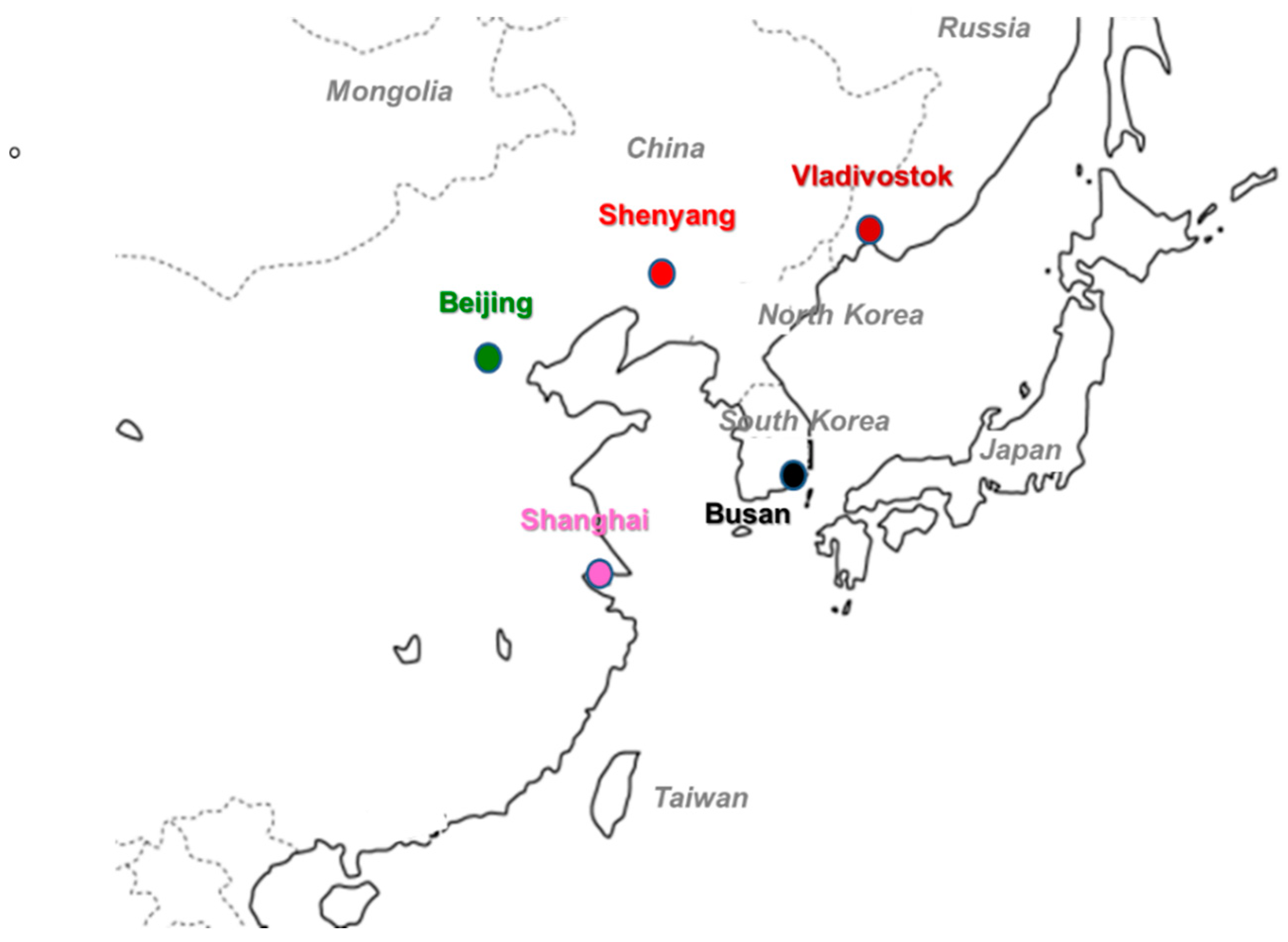
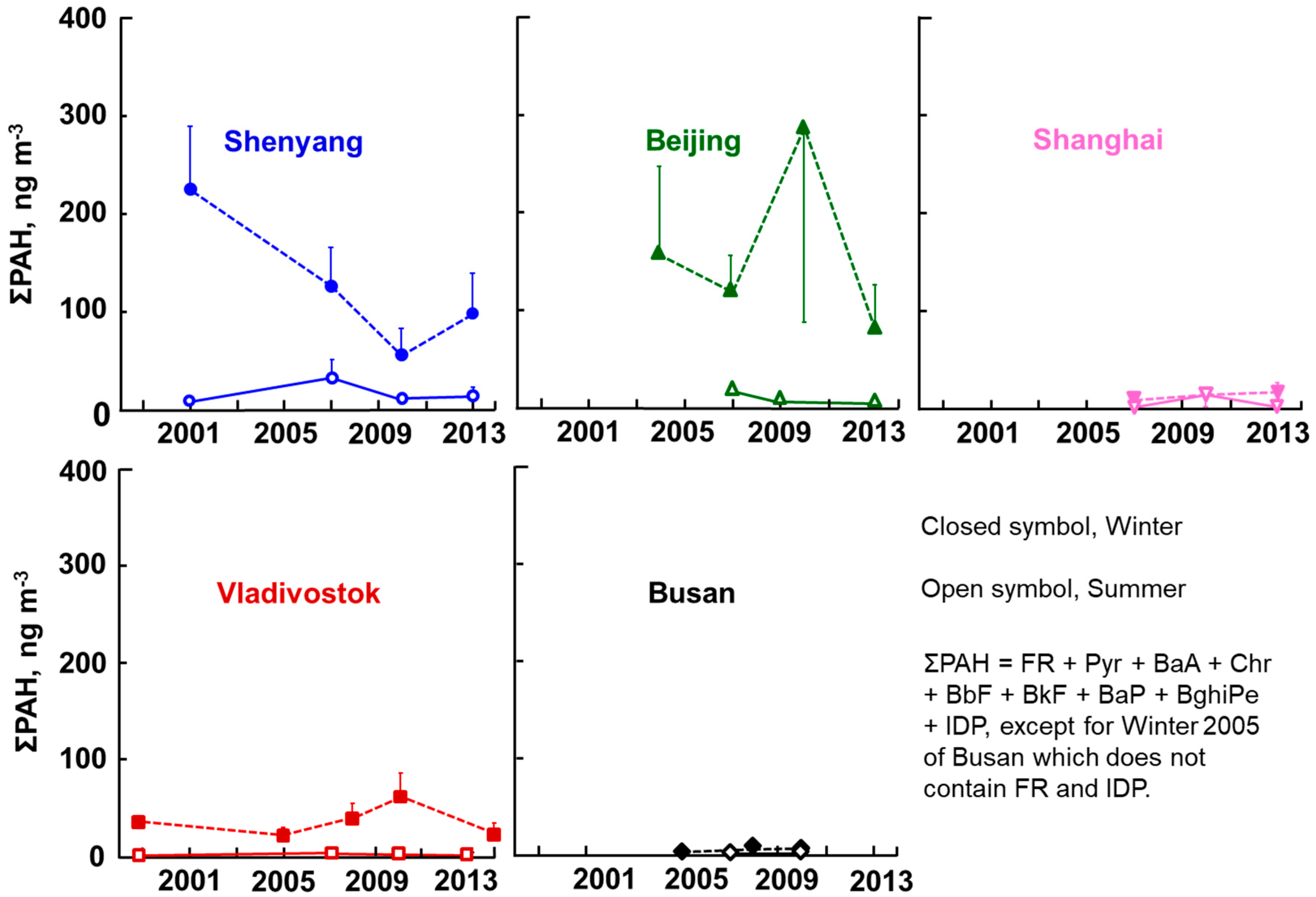
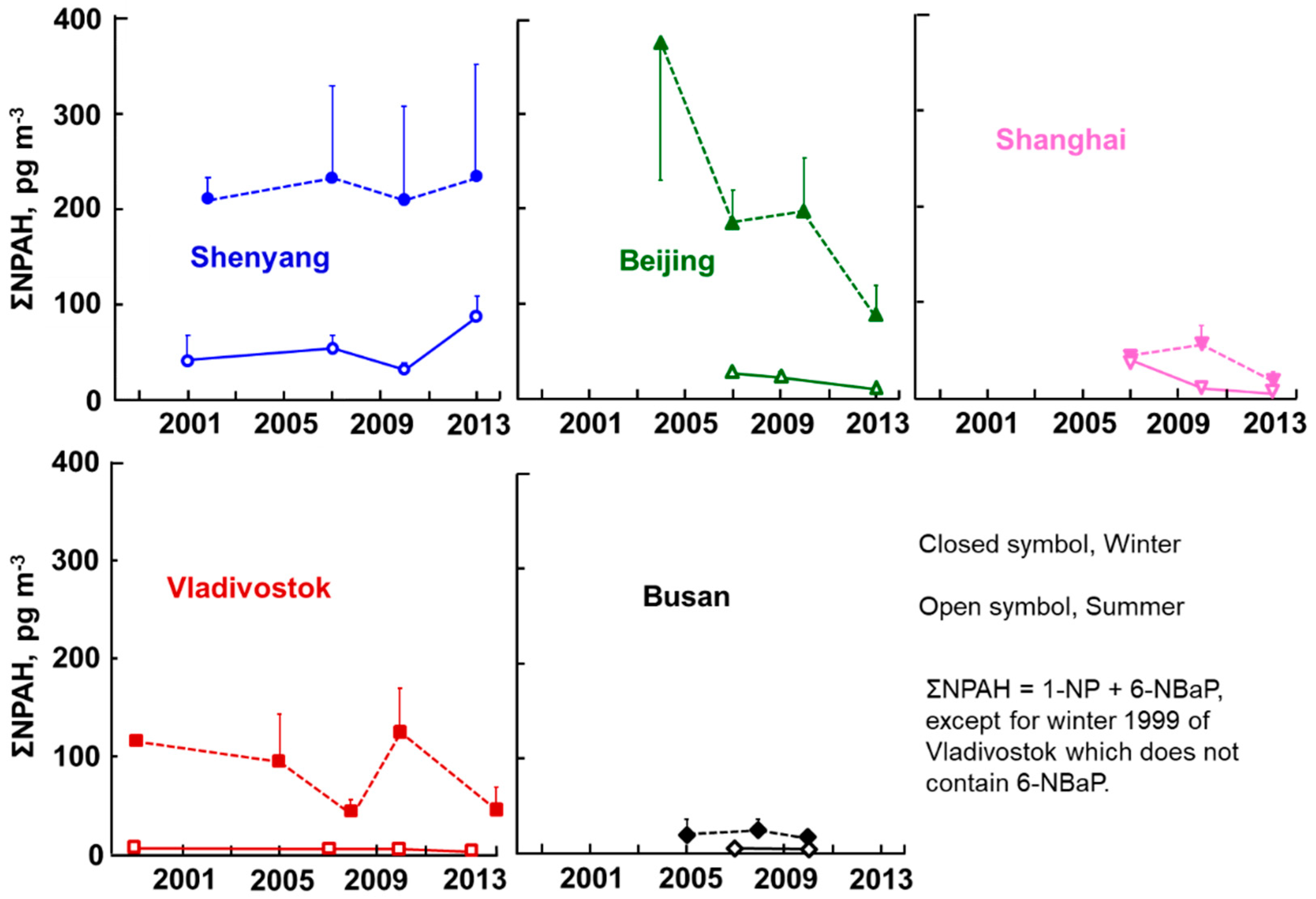
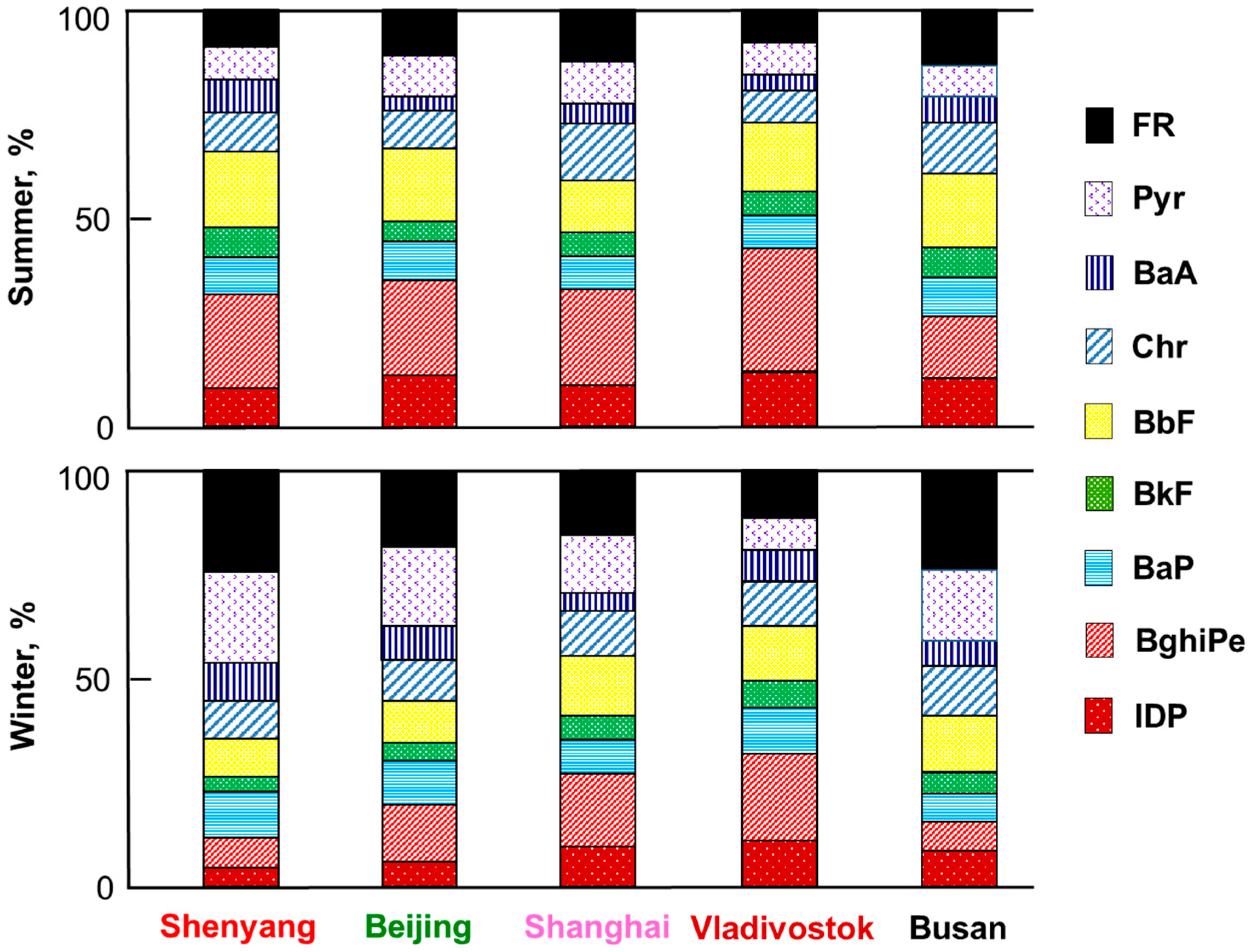
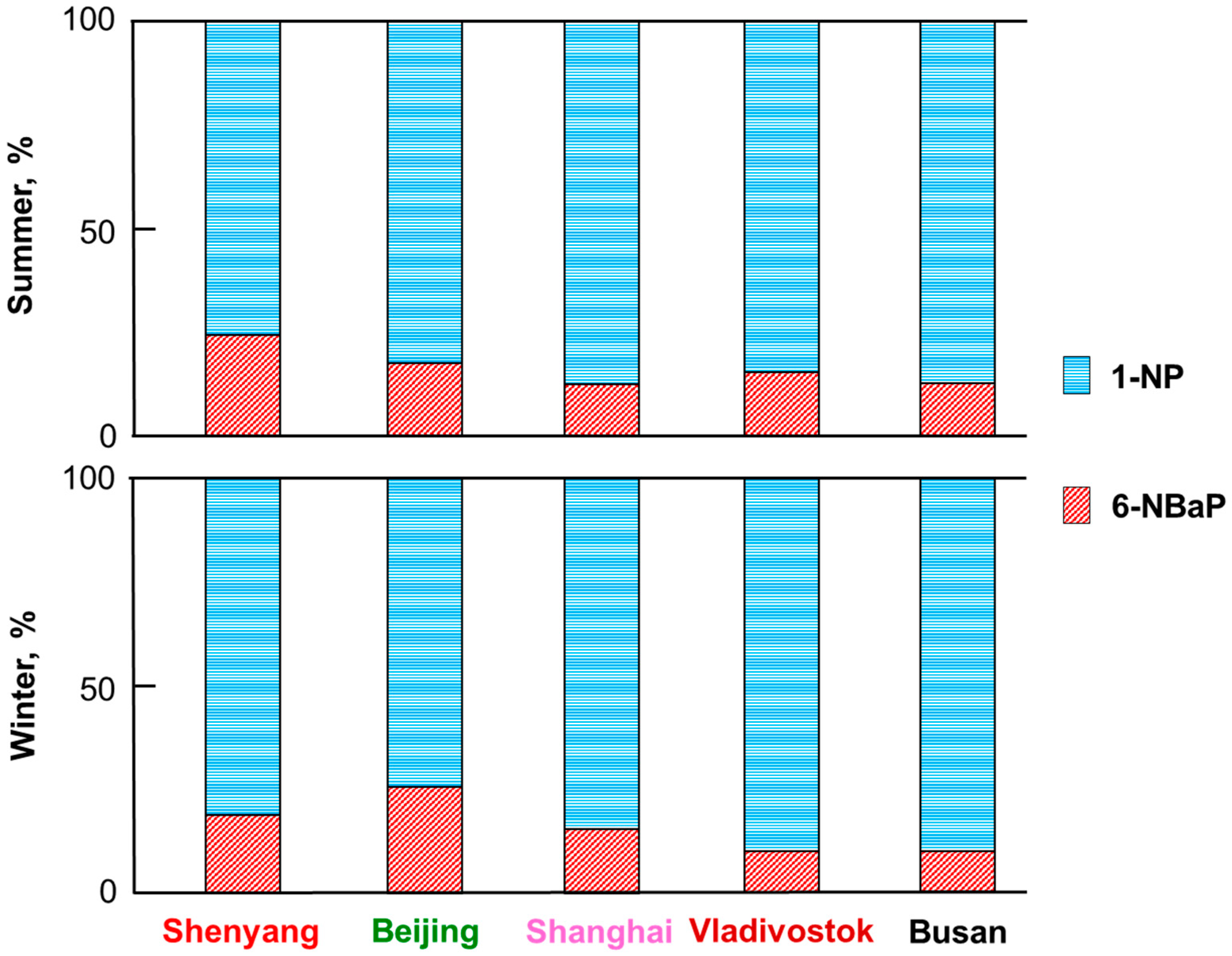
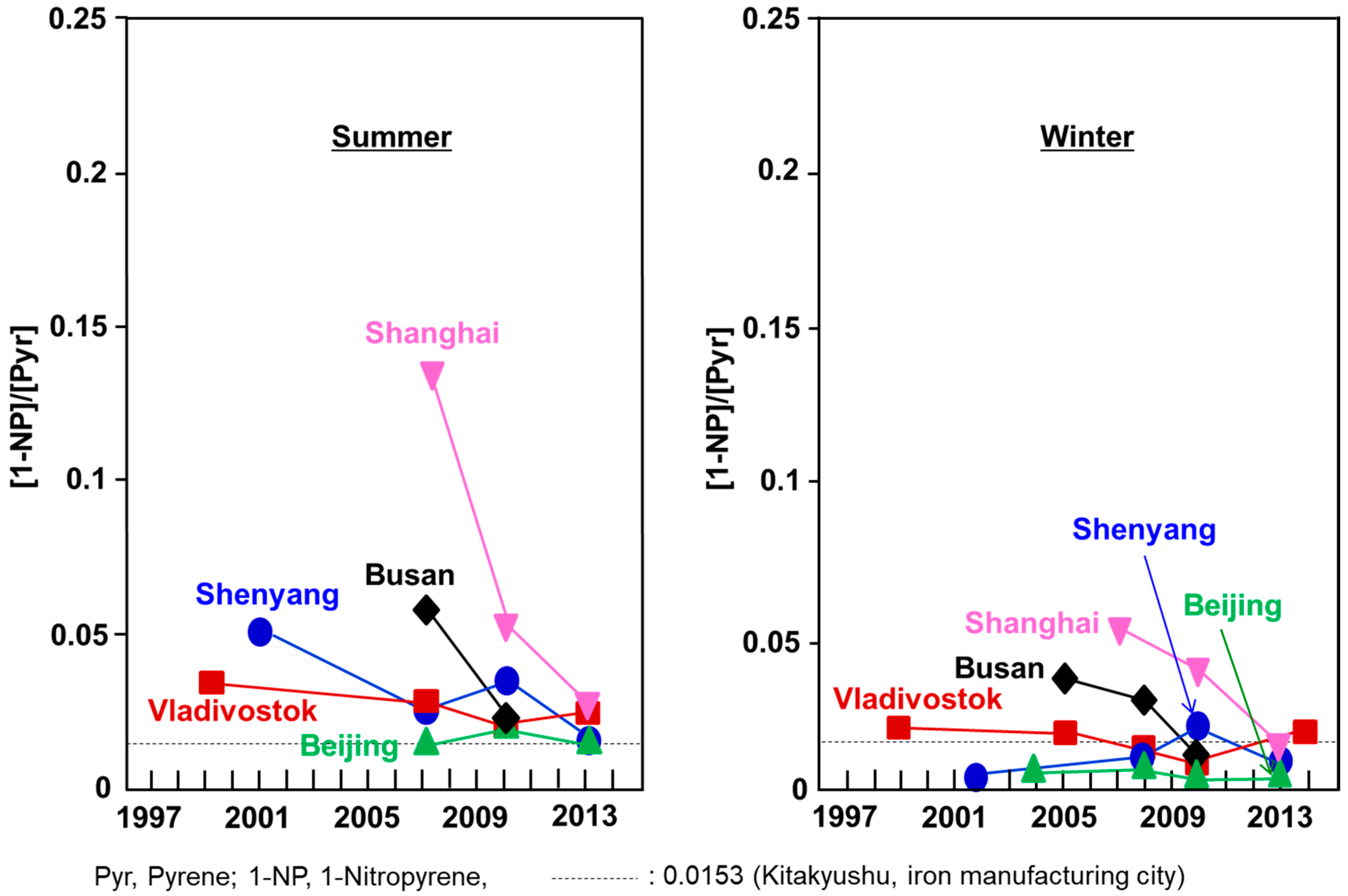
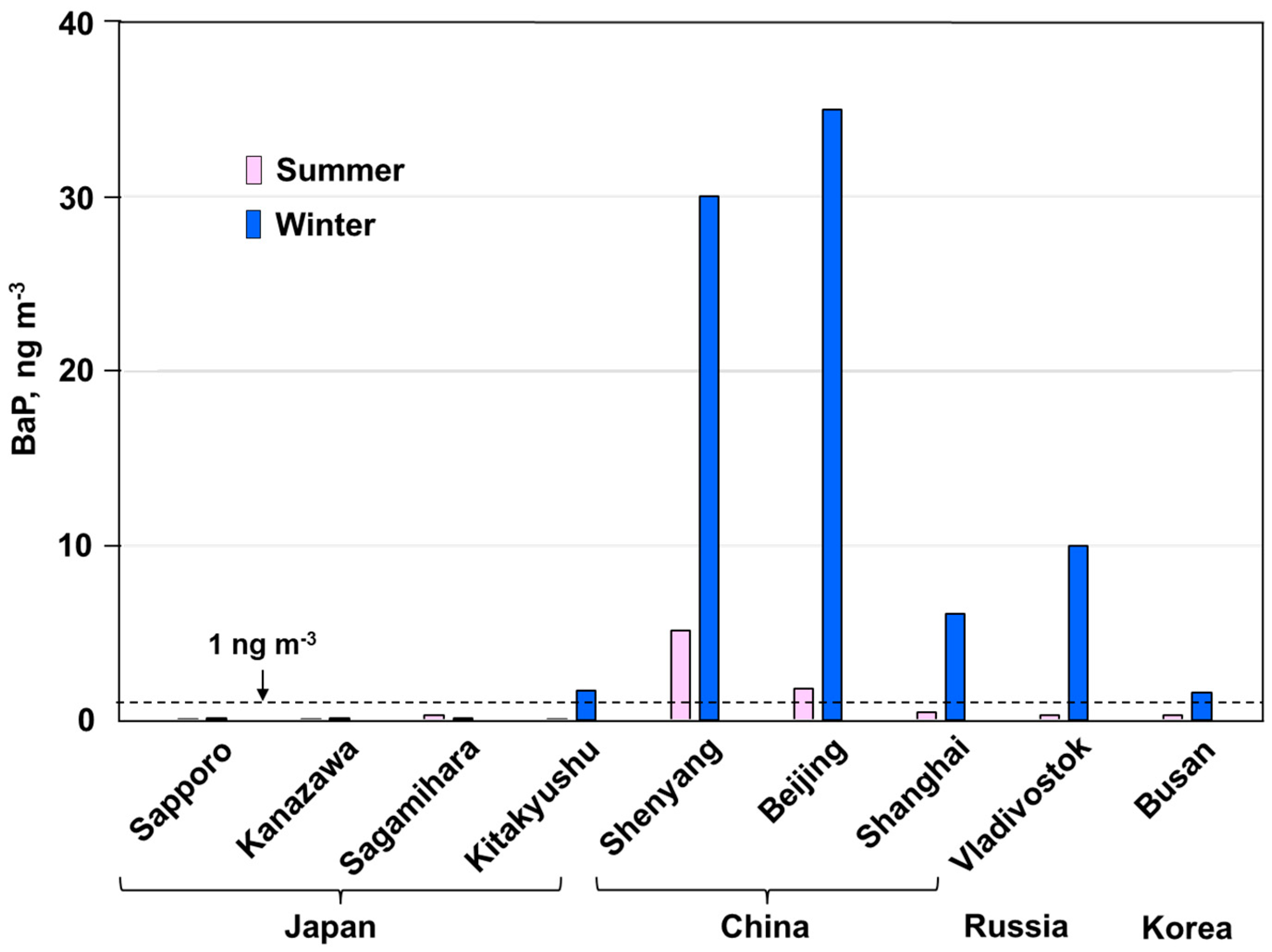
| City | Location | Population | Temp. (Avg.), °C | Capital/Main Industry | |
|---|---|---|---|---|---|
| Latitude, Longitude | Summer | Winter | |||
| Shenyang | 41°37′ N, 123°25′ E | 8,250,000 | 22.1 | −12.1 | Capital of Liaoning Province/the economic and industrial center of northeastern China |
| Beijing | 39°54′ N, 116°24′ E | 21,700,000 | 25.2 | −2.4 | Capital city of China/political center |
| Shanghai | 31°13′ N, 121°27′ E | 24,300,000 | 26.5 | 5.4 | City under the direct control of the Chinese government/the economic, financial, and industrial center of China |
| Vladivosok | 43°06′ N, 131°52′ E | 600,000 | 16.8 | −10.3 | Capital of Primorsky Krai in Russia/a port city with shipping and fishing |
| Busan | 35°06′ N, 129°02′ E | 3,400,000 | 23.7 | 3.7 | Korea’s second city/port city, which plays an important role in politics, the economy, and culture |
© 2020 by the authors. Licensee MDPI, Basel, Switzerland. This article is an open access article distributed under the terms and conditions of the Creative Commons Attribution (CC BY) license (http://creativecommons.org/licenses/by/4.0/).
Share and Cite
Hayakawa, K.; Tang, N.; Nagato, E.; Toriba, A.; Lin, J.-M.; Zhao, L.; Zhou, Z.; Qing, W.; Yang, X.; Mishukov, V.; et al. Long-Term Trends in Urban Atmospheric Polycyclic Aromatic Hydrocarbons and Nitropolycyclic Aromatic Hydrocarbons: China, Russia, and Korea from 1999 to 2014. Int. J. Environ. Res. Public Health 2020, 17, 431. https://doi.org/10.3390/ijerph17020431
Hayakawa K, Tang N, Nagato E, Toriba A, Lin J-M, Zhao L, Zhou Z, Qing W, Yang X, Mishukov V, et al. Long-Term Trends in Urban Atmospheric Polycyclic Aromatic Hydrocarbons and Nitropolycyclic Aromatic Hydrocarbons: China, Russia, and Korea from 1999 to 2014. International Journal of Environmental Research and Public Health. 2020; 17(2):431. https://doi.org/10.3390/ijerph17020431
Chicago/Turabian StyleHayakawa, Kazuichi, Ning Tang, Edward Nagato, Akira Toriba, Jin-Min Lin, Lixia Zhao, Zhijun Zhou, Wu Qing, Xiaoyang Yang, Vassily Mishukov, and et al. 2020. "Long-Term Trends in Urban Atmospheric Polycyclic Aromatic Hydrocarbons and Nitropolycyclic Aromatic Hydrocarbons: China, Russia, and Korea from 1999 to 2014" International Journal of Environmental Research and Public Health 17, no. 2: 431. https://doi.org/10.3390/ijerph17020431
APA StyleHayakawa, K., Tang, N., Nagato, E., Toriba, A., Lin, J.-M., Zhao, L., Zhou, Z., Qing, W., Yang, X., Mishukov, V., Neroda, A., & Chung, H.-Y. (2020). Long-Term Trends in Urban Atmospheric Polycyclic Aromatic Hydrocarbons and Nitropolycyclic Aromatic Hydrocarbons: China, Russia, and Korea from 1999 to 2014. International Journal of Environmental Research and Public Health, 17(2), 431. https://doi.org/10.3390/ijerph17020431






